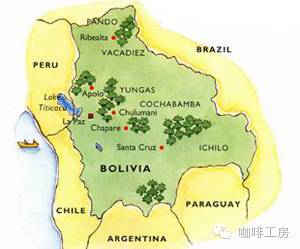Flavor characteristics of Bolivian coffee beans Why are delicious coffee beans precious after death on the road?
Bolivia, which has a small population and is quite poor, depends on minerals and natural gas and agriculture, and coffee cultivation is only a minority. Many farmers grow coca leaves because the price fluctuation of coca leaves is relatively small and can provide more living security. Bolivia's unique geographical environment is conducive to the growth of coffee, high enough altitude, dry and wet climate. But poverty and poor infrastructure are key factors in coffee handling, transportation and quality killers.
The United States has set up several small wet coffee treatment plants in Bolivia, and even though the coffee industry has made many improvements to improve quality, Bolivian coffee still lacks the reputation of neighboring Colombia and Brazil. Bolivia's coffee production is dominated by a smallholder production system, with 23000 households producing coffee in the country.
Most of the coffee in China belongs to ancient native species, such as Itsuka and Kaddura.
Flavor and palate: the taste of high-quality Bolivian coffee is mostly very sweet and pure, rarely fruity. Bolivia's diverse terrain is called a paradise for micro-batches of boutique coffee, but it is not too much.
Producing areas:
YUNGAS
95% of Bolivia's coffee comes from this area and is covered by a whole forest. It has one of the best high-altitude coffee in the world and is the oldest producing area in Bolivia.
The most famous producing area is La Paz La Paz, west of Yungas, and coffee buyers must go through the famous "Yongas Road" to visit coffee producers. The road is usually an one-way street, quite tortuous, and there is no protective fence to protect the vehicle from falling 600 meters down the valley. This road is also called "the most dangerous road in the world". With a vast territory, coffee roasters use regions to describe coffee producing areas, such as Caranavi and Inquisivi, with an elevation of 800-2300 meters above sea level and a harvest period from July to November.
Santa Cruz
In the easternmost part of Bolivia, the altitude is not high and there is not much high-quality coffee. It is 410 meters above sea level and the harvest period is from July to November.
BENI
Located in the northeast of Bolivia, it has a vast territory and sparsely populated area. Some of them belong to YUNGAS geography. It is 155 meters above sea level and the harvest period is from July to November.

Important Notice :
前街咖啡 FrontStreet Coffee has moved to new addredd:
FrontStreet Coffee Address: 315,Donghua East Road,GuangZhou
Tel:020 38364473
- Prev

The result of the 16th Nicaragua Excellence Cup in 2020 is announced. When will the auction of COE start?
Portland, Oregon (June 5, 2020)-the Coffee Excellence Alliance announced the winning Coffee at the 16th Outstanding Cup in Nicaragua. Nicaragua's winning cup returned to the country after an one-year truce, providing a total of 249 cups of coffee (of which 74% were produced for the first time). At this year's Expo, 17 cups of coffee won the Outstanding Cup, and 12 cups of coffee were awarded the national championship. Have to
- Next

Rose summer or blue mountain is good? Blue Mountain debuts Jamaica Blue Mountain Rosedale Coffee Flavor Characteristics
Front Street Coffee launched its new season of Jamaica Blue Mountain earlier this year, featuring an added sun treatment that many people don't know what that means. Blue Mountain Coffee was popular in the age of Mantedin, Brazil and Colombia. The traditional mellow flavor was different from them. The flavor balance was realized in many ways. Therefore, in the coffee world at that time,
Related
- What is the standard process for the purpose of coffee cup testing? What is the difference between hand-brewed coffee and cup testing?
- How to use hand-brewed coffee paragon small golden balls? How does cold coffee lock in the aroma of coffee?
- Is American coffee black? What is the difference between American coffee and drip coffee?
- Unexpected! Well-known tea beverage brand Lele Tea will withdraw from the Zhengzhou market!
- Starbucks enters the fashion and beauty industry?! Netizen: Give me an ice American eye cream
- Why can American refills for free? The difference between Americano and American drip pot coffee
- Being chased out of the rain in front of Starbucks?! Store: Sheltering from rain under umbrellas poses a safety hazard
- The white moonlight has changed?! Lucky launches "Big Winter Pear American"
- Hand-brewed coffee three-stage method, high-sweet and universal brewing method to share! What does the high sweet water level of hand-brewed coffee mean?
- What is the difference between raw, refined and full espresso coffee? How to extract espresso and taste good?

